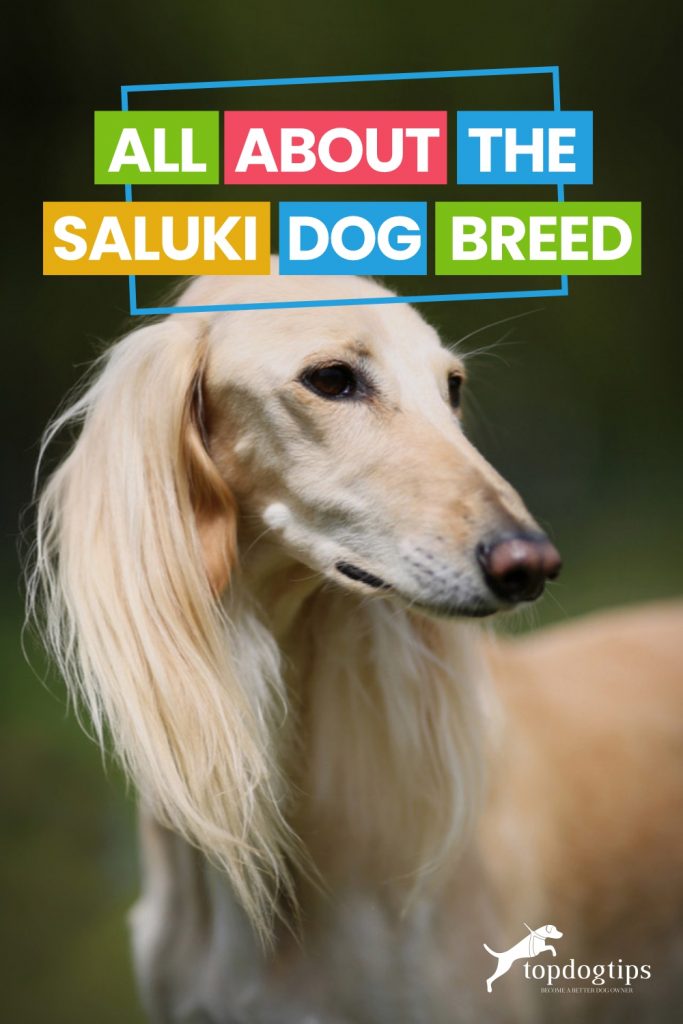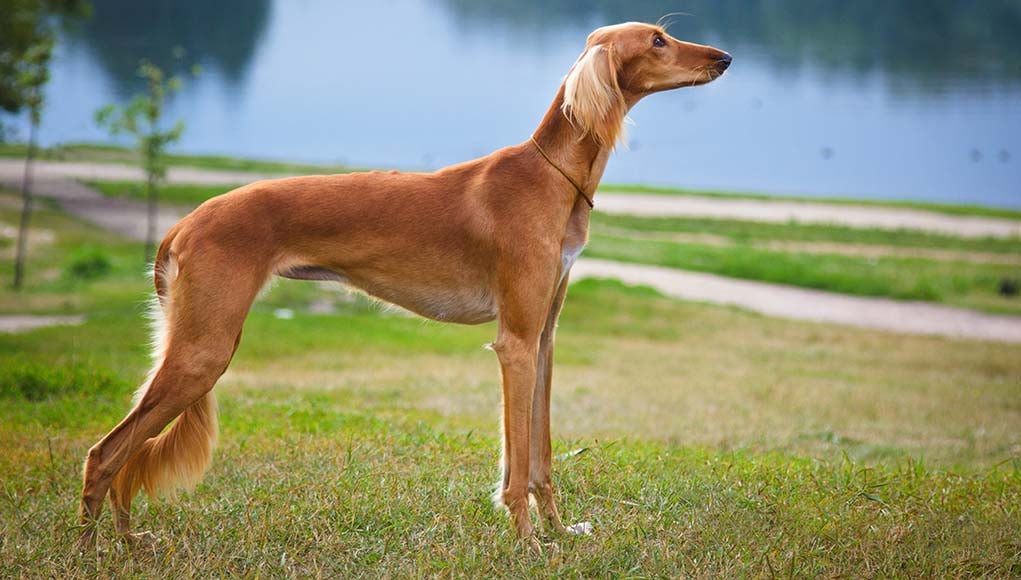If you haven't seen a Saluki dog breed or know much about it, we've got you covered.
This is a guide to the Saluki breed and what you need to know.
After reading, you will be equipped to make a decision if this breed is right for your family.
To start, it looks a bit like a cross between an Afghan hound and a Greyhound. Once you see one, you'll know exactly what we mean.
As one of the most graceful-looking dogs, as well as one of the oldest breeds in the world, the Saluki has a lot of interesting history behind it.
Here's a snapshot of the Saluki dog, including their background, appearance, exercise needs, temperament, and more.
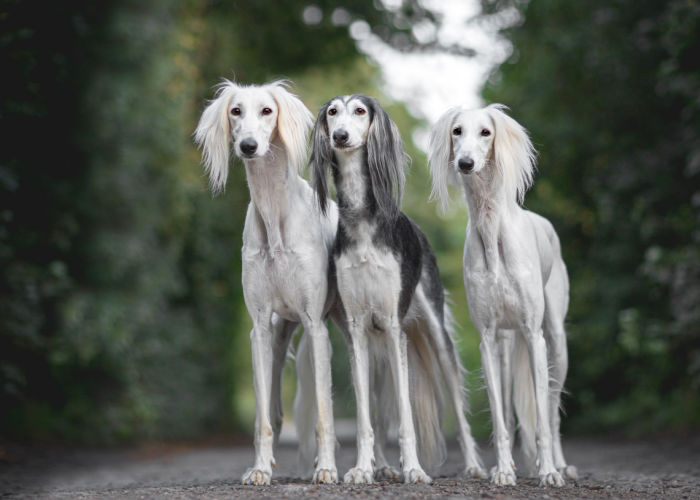
Saluki Dog Appearance
The Saluki is an elegant-looking, slim dog with long, athletic legs.
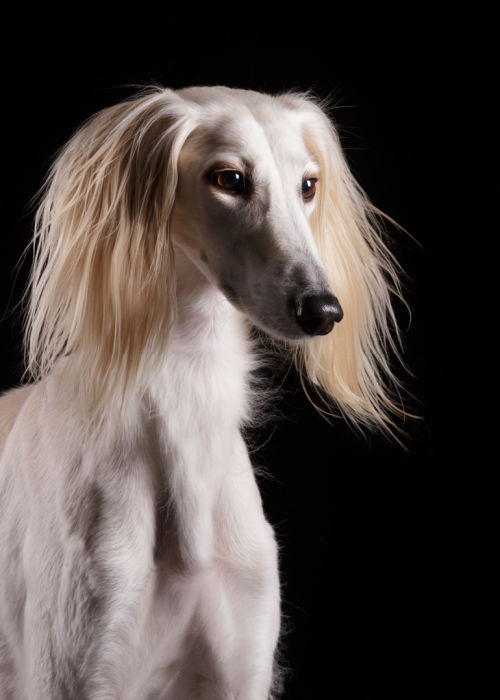
Their eyes are often hazel colored and oval-shaped, sitting atop their long, narrow head.
Their ears are quite long, and some Saluki owners choose to accentuate the look by letting the silky hair on their
ears grow, reaching past their shoulders.
The same is true of the fur on their long tail, which is often feathered and has a flowy, elegant appearance.
The Saluki's coat varies in color and sheds very little.
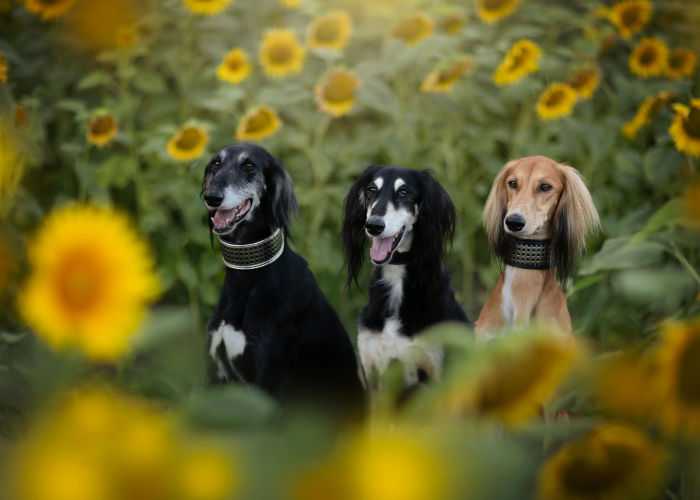
Fawn is the standard color for a typical Saluki, while other Salukis can also be red, gold, cream, tan, white/silver.
Although females tend to be considerably smaller than males, the Saluki dog can reach between 23 – 28 inches high at the shoulders and weigh between 40 – 65 pounds.
RELATED: 11 Popular Hound Dog Breeds
Saluki Dog History
The Saluki dog sure has a rich history.
Throughout the years, it has also been called a Persian Greyhound, Gazelle Hound, and Arabian Hound.
Although it is considered the royal dog of Egypt, it is actually native to Turkey and surrounding regions.
It's name comes from an old Arabian city that no longer exists.
Evidence suggests that the Saluki is one of the oldest dog breeds that was domesticated in the world. Their bodies were often found mummified with their Pharaoh owners in tombs that also had their pictures inscribed in them.
Historically, Muslims considered Salukis to be sacred gifts from Allah.
They were so special that they could not be bought on the market. Instead, you would have to have been given one as a gift of honor or friendship.
The Arabs used Salukis to hunt gazelle, hares, and jackals.
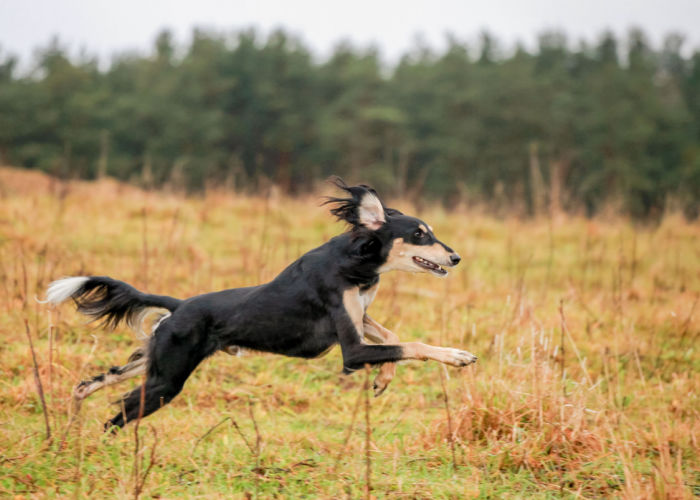
This was due to their speed and agility, especially over rough terrain.
Considering how fast those creatures are, it provides an idea of just how fast a Saluki could run.
When reaching their highest speeds — which can be up to 50 miles per hour — they appear as if they're floating, with all four legs suspended in the air at the same time.
The American Kennel Club first recognized the Saluki in 1927. The Saluki Club of America was then established as AKC's parent club for Saluki enthusiasts in the United States.
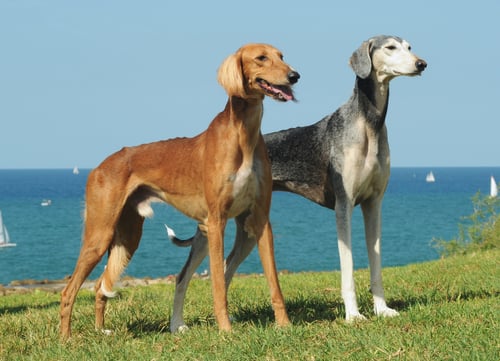
YOU MIGHT BE INTERESTED: Dog Domestication: History’s Timeline From Beginning To Now (In Years)
Saluki Dog Temperament
Salukis can make a great pet for the right family. They're loyal to their owners, but they are also very independent.
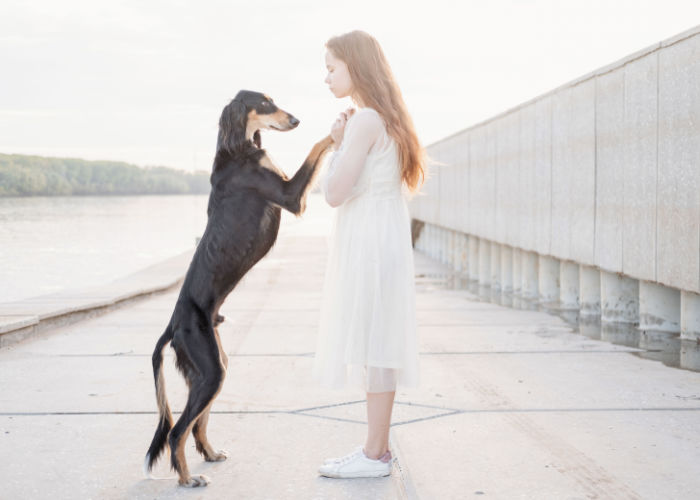
This roots in their history as independent hunters, too fast for humans to keep up with.
Their independence can make them seem aloof, almost like a cat, but that doesn't mean they like to be left alone.
Although Salukis are capable of being avid hunters and resilient to desert heat and terrain, that doesn't mean they don't like living a luxurious lifestyle.
They enjoy soft surfaces to lie on since they don't have much body fat to act as natural padding.

And although you may find them perfectly happy curled up next to you in bed or on the couch, that doesn't mean they don't need physical activity.
In fact, the opposite is true. They're incredibly athletic and need lots of opportunities for physical activity.
If they live an active, healthy lifestyle, they can live up to 17 years.
Salukis can be easily distracted and sensitive to harsh discipline. For that reason, some people find them difficult to train.
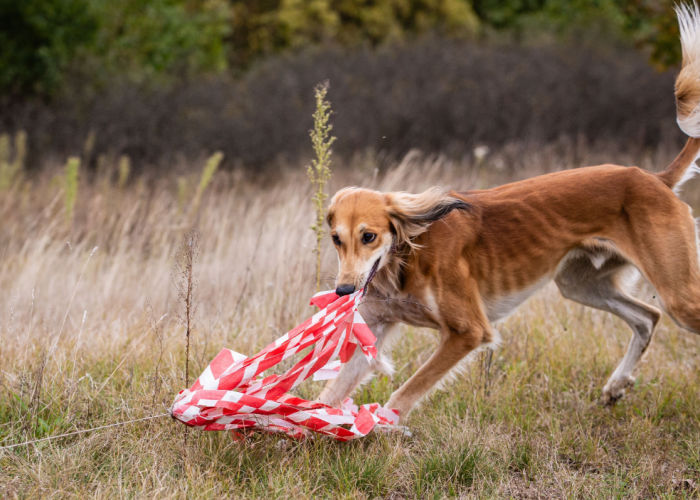
But with any dog, patience is key.
Showing them that you're the pack leader will help them feel more confident and comfortable in their surroundings, which in turn can make them easier to train.
Although Salukis are gentle with kids and even family cats if raised together, it is important to remember that they were bred to hunt small, non-canine animals.
For that reason, you should never leave a Saluki unleashed outdoors or in a home with small animals.
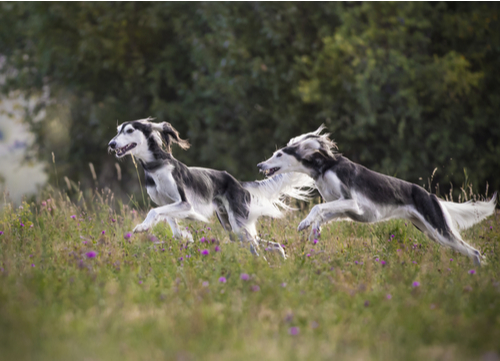
YOU MIGHT BE INTERESTED: 20 Most Ancient Dog Breeds
The Needs of a Saluki Dog
Salukis are very adaptable and make loyal pets, but they do have specific needs that all owners should be aware of.
For example, although you may find them often curled up on a comfy chair in the corner of a room, that doesn't mean laying around alone is good for them.
They are not suited for small apartments and instead need lots of room.
This is especially true outdoors, where they need to be able to run.
A fenced-in yard is ideal due to its extreme prey drive.
Exercise
Keeping your Saluki active is key to preventing unwanted behaviors in your home.
At a minimum, Salukis need a long-brisk, walk daily. However, some Salukis may need much more exercise to keep them happy.
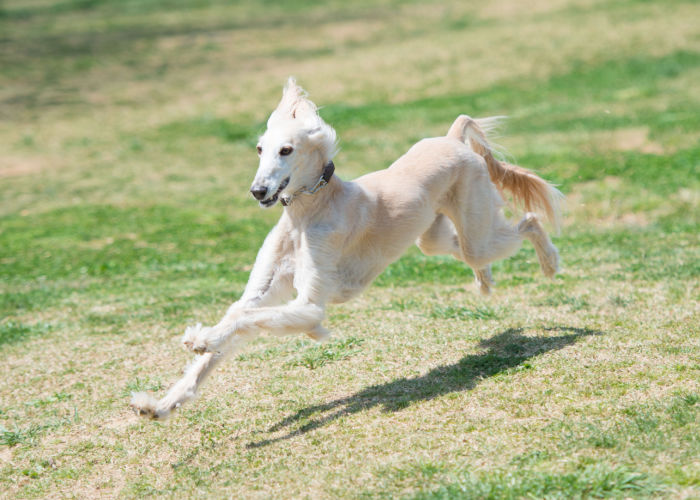
They have amazing endurance, so a simple walk is not likely to challenge them much.
Instead, running them alongside your bike should get them up to a speed they're most comfortable with.
Don't overwork them, though. A moderate, easy pace on your bike should be enough.
Be prepared if your Saluki sees a small animal while you're running or biking with them.
Without training them to leave the animal alone, you could find that they end up pulling you through the fields in whatever direction the animal is going.
And since they're sighthounds, they may be so focused on keeping their prey in view that they ignore any verbal cues you're giving them.
Remember that this is in their nature, and they're not doing it intentionally to be bad dogs.
When possible, choose locations and environments where distractions from small animals are kept to a minimum.
Training
Obedience training for young Salukis is very important. It's because a Saluki puppy can be quite destructive; all those pent-up energies might possibly be spent on jumping off of couches or chewing shoes.
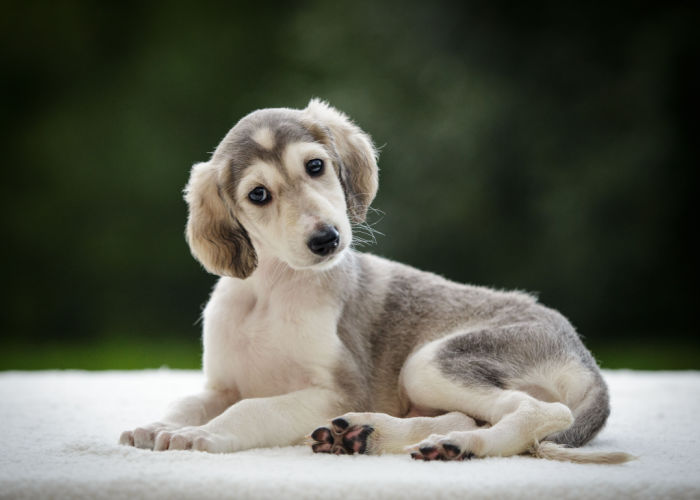
However, this phase is only temporary. And the sooner they'll undergo training, the sooner this phase will fade off.
As other dogs require, crate training and basic obedience training are also recommended for a Saluki.
For mental stimulation, this breed will also benefit from getting agility training.
Early socialization is also key in teaching them how to be friendly with other dogs.
Nutrition
Whether you're giving them commercially available kibble or a homemade meal, as long as they eat high-quality dog food, your Saluki should be fine.

But as a general rule, it's best to consult your veterinarian if you prefer making a homemade meal for your dog.
You should also ask your vet about the quantity of food you should be giving them.
Grooming
Grooming Salukis is easy. They are generally odor-free and have a short coat over most of their body.
Just be sure to brush it weekly. It may need more brushing the more feathering it has, however.
You might also want to use a snood if your dog has a long ear feathering to keep it off of their food bowl when feeding or drinking.
With the proper care and a lifestyle that matches, you might find that you're an ideal owner for this amazing dog.
YOU MIGHT BE INTERESTED: Non-Shedding Dog Breeds (Ranking the Dogs That Don’t Shed)
Common Health Problems for a Saluki Dog
Just like other breeds, there are common health problems Saluki owners should be aware of.
Progressive Retinal Atrophy
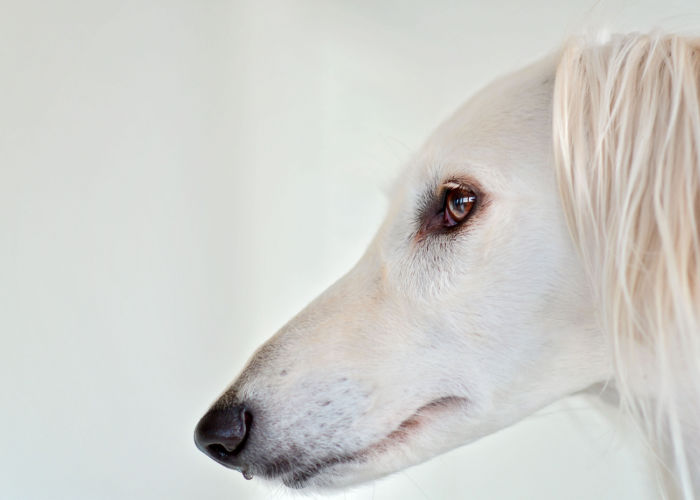
PRA, or Progressive Retinal Atrophy, is pretty common for a lot of similar breeds, and the Saluki is no exception.
This is an inherited disease that could cause partial or complete blindness in an eye or both eyes.
Because this disease is hereditary, it's important that you see the health clearance first of a Saluki puppy's parents to make sure the dog you are purchasing or adopting won't suffer from PRA later on in their life.
Von Willebrand Disease
The Von Willebrand Disease is one of the genetic diseases a Saluki dog breed could also get.
This is a blood condition where the Von Willebrand factor, a type of protein naturally found in blood, functions abnormally, which causes excessive bleeding.
VWD also makes clotting difficult for an open wound. If left unchecked, your Saluki's VWD may lead to a life-threatening emergency.
Because of this, breeding a dog with this condition is not advisable.
Hypothyroidism
One of the most common hormonal problems among dogs, hypothyroidism affects the thyroid gland found in the neck.
It slows down the hormone-making gland, which, in turn, slows down the metabolic rate, resulting in weight gain and lethargic behavior.
Hypothyroidism is most common in purebred dogs like Saluki.
Apart from the abovementioned, Saluki is also prone to some genetic eye diseases, as well as cancer.
Special care should be taken in the sun, as the position of the nose on the face makes it prone to sunburn.
When properly cared for, the Saluki dog breed's life expectancy can reach up to 12-14 years.
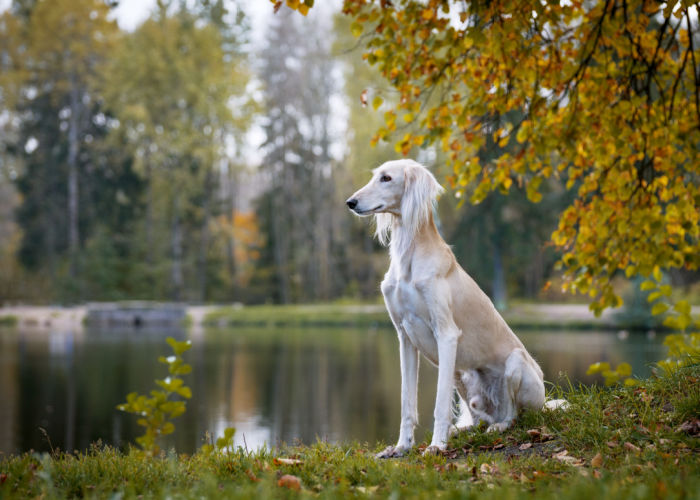
Fun Facts About the Saluki Dog Breed
- Salukis are one of the known world's oldest breeds. They may even be around already when Alexander the Great invaded India in 329 BC.
- They are used by the Arabs to hunt gazelles, the fastest among antelopes.
- Considered the Royal dog of Egypt, deceased Salukis were given special treatment. They were also mummified like Pharaohs!
- Their eyes are as sharp as they can get—no wonder they are considered valuable Sighthounds.
YOU MIGHT BE INTERESTED: 25 Fastest Dog Breeds On the Planet
FAQs on the Saluki Dog Breed
Is Saluki a good family dog?
Saluki owners can testify that this breed is a good family dog. They're loyal and devoted but not particularly showy.
Pet Salukis have the tendency to be aloof with people they don't know. However, they are gentle with children. They're also quiet and are good with other dogs.
Can Salukis be aggressive?
Salukis are actually sensitive dogs. They are mellow-mannered and aloof.
Because of this, a Saluki doesn't have any tendency to be aggressive.
They are excellent watchdogs, though, because of their innate hunting instincts.
Do Salukis bark a lot?
No, Salukis don't bark a lot. In fact, Salukis are generally quiet.
Despite their appearance, they are actually not a hyperactive breed (especially when properly trained as a puppy.)
Are Salukis hard to train?
Salukis have the tendency to take their time and do things at their own speed. Because of this, you may find it difficult to train a Saluki.
But that doesn't mean they don't learn—they do! They will just require more time and patience than other breeds.
Don't forget to use positive reinforcement, though. Negative training methods won't sit well with this sensitive dog.
Is a Saluki faster than a Greyhound?
We often hear Greyhounds as the fastest dog breed, but the Guinness Book of Records listed a Saluki as the fastest one in 1996 when said dog was able to reach a speed of 68.8km/h.
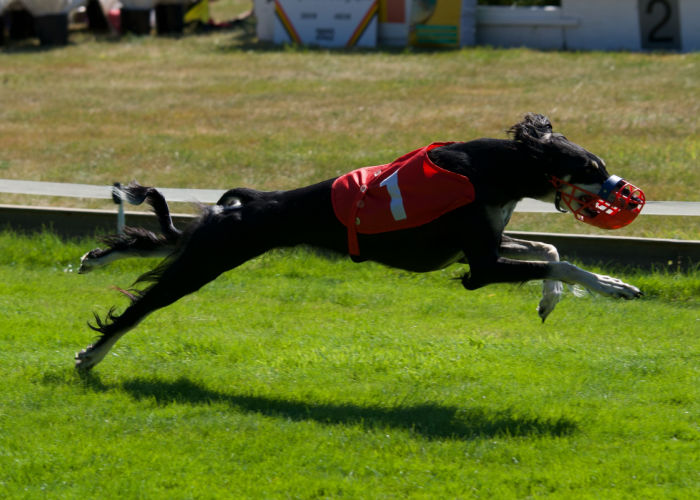
Saluki Dog Breed – Final Thoughts
If you're looking into getting a dog that's surely going to be a head-turner, one that's reserved and independent, a loyal companion, and a good family dog, the Saluki dog breed might be the one for you.
Read Next: Racing Dog Breeds
